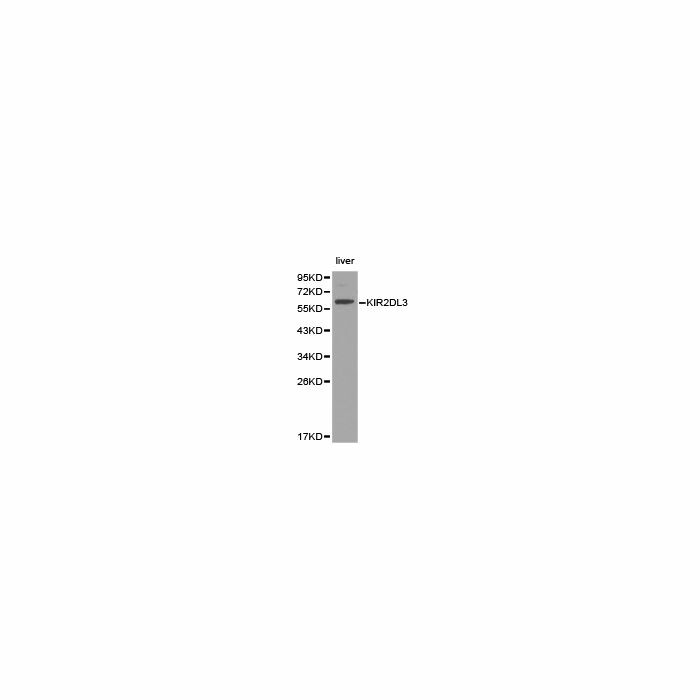CD158b2 (KIR2DL3) polyclonal, anti-human, mouse
€388.00
In stock
SKU
BS6643
Background:
NKAT (NK-associated transcripts) gene products, known as killer immuno-globulin-like receptors or KIRs, downregulate the cytotoxicity of NK cells upon recognition of specific class I major histocompatibility complex (MHC) molecules on target cells. This family of receptors is characterized by an extracellular region with two to three immunoglobulin-superfamily domains and a cytoplasmic domain with an antigen receptor activation motif (ARAM). KIRs and other inhibitory receptors also possess a common cytoplasmic sequence (I/VxYxxL/V) known as an ITIM (immunoreceptor tyrosine-based inhibitory motif). The human inhibitory human killer cell immunoglobulin-like receptor 2DL3 (KIR2DL3), also referred to as CD158b, is an inhibitory receptor that is specific for the human MHC class I molecule HLA-Cw3 and related alleles.
Alternative Name:
Killer cell immunoglobulin-like receptor 2DL3, CD158 antigen-like family member B2, KIR-023GB, Killer inhibitory receptor cl 2-3, MHC class I NK cell receptor, NKAT2a, NKAT2b, Natural killer-associated transcript 2, NKAT-2, p58 natural killer cell receptor clone CL-6, p58 NK receptor CL-6, p58.2 MHC class-I-specific NK receptor, CD158b2, KIR2DL3, CD158B2, KIRCL23, NKAT2
Application Dilution: WB: 1:500~1:2000, IF: 1:50~1:200
Specificity: KIR2DL3 polyclonal antibody detects endogenous levels of KIR2DL3 protein.
Immunogen:
Recombinant full length Human KIR2DL3.
MW: ~ 38 kDa
Swis Prot.: P43628
Purification & Purity:
The antibody was affinity-purified from rabbit antiserum by affinity-chromatography using epitope-specific immunogen and the purity is > 95% (by SDS-PAGE).
Format:
1mg/ml in PBS with 0.1% Sodium Azide, 50% Glycerol.
Storage:
Store at 4°C short term. Aliquot and store at -20°C long term. Avoid freeze-thaw cycles.
For research use only, not for use in diagnostic procedure.
NKAT (NK-associated transcripts) gene products, known as killer immuno-globulin-like receptors or KIRs, downregulate the cytotoxicity of NK cells upon recognition of specific class I major histocompatibility complex (MHC) molecules on target cells. This family of receptors is characterized by an extracellular region with two to three immunoglobulin-superfamily domains and a cytoplasmic domain with an antigen receptor activation motif (ARAM). KIRs and other inhibitory receptors also possess a common cytoplasmic sequence (I/VxYxxL/V) known as an ITIM (immunoreceptor tyrosine-based inhibitory motif). The human inhibitory human killer cell immunoglobulin-like receptor 2DL3 (KIR2DL3), also referred to as CD158b, is an inhibitory receptor that is specific for the human MHC class I molecule HLA-Cw3 and related alleles.
Alternative Name:
Killer cell immunoglobulin-like receptor 2DL3, CD158 antigen-like family member B2, KIR-023GB, Killer inhibitory receptor cl 2-3, MHC class I NK cell receptor, NKAT2a, NKAT2b, Natural killer-associated transcript 2, NKAT-2, p58 natural killer cell receptor clone CL-6, p58 NK receptor CL-6, p58.2 MHC class-I-specific NK receptor, CD158b2, KIR2DL3, CD158B2, KIRCL23, NKAT2
Application Dilution: WB: 1:500~1:2000, IF: 1:50~1:200
Specificity: KIR2DL3 polyclonal antibody detects endogenous levels of KIR2DL3 protein.
Immunogen:
Recombinant full length Human KIR2DL3.
MW: ~ 38 kDa
Swis Prot.: P43628
Purification & Purity:
The antibody was affinity-purified from rabbit antiserum by affinity-chromatography using epitope-specific immunogen and the purity is > 95% (by SDS-PAGE).
Format:
1mg/ml in PBS with 0.1% Sodium Azide, 50% Glycerol.
Storage:
Store at 4°C short term. Aliquot and store at -20°C long term. Avoid freeze-thaw cycles.
For research use only, not for use in diagnostic procedure.
| Is Featured? | No |
|---|
Write Your Own Review

